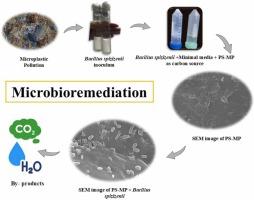新型PGPR芽孢杆菌降解聚苯乙烯微塑料
IF 11.3
1区 环境科学与生态学
Q1 ENGINEERING, ENVIRONMENTAL
引用次数: 0
摘要
本研究探索了植物促生根瘤菌spizizenii作为聚苯乙烯微塑料(PS-MP)降解剂的新用途。当聚苯乙烯(PS)作为唯一的碳源时,在30天内,MP的降解效率达到了令人印象深刻的85.86%。傅里叶变换红外光谱(FTIR)证实了PS- mp峰强度的显著变化,表明PS被击穿。此外,在扫描电子显微镜(SEM)成像中,PS表面降解清晰可见。30天后使用气相色谱-质谱(GC-MS)进行代谢分析。利用KEGG数据库中的代谢数据,概述了尖孢芽孢杆菌的潜在降解途径。通过产吲哚乙酸(IAA)、磷酸增溶、氨、氰化氢(HCN)和产铁载体证实了spizizenii的PGPR性状。结果为PS降解提供了一种新的候选材料。PGPR的特性进一步为塑料污染土壤修复提供了可行性。微塑料污染(MP),特别是来自聚苯乙烯等弹性材料的微塑料污染,对土壤生态系统和生物多样性构成了严峻的环境挑战。管理MP污染的传统方法往往效率低下或有害,强调需要可持续的解决方案。尽管在微生物降解方面取得了进展,但有限的研究已经探索了同时降解塑料和增强土壤健康的生物制剂。本研究通过展示spizizenii的双重潜力,解决了这一空白,在促进土壤健康的同时,在30天内实现了85.86%的聚苯乙烯降解。通过将生物降解与土壤恢复结合起来,我们的研究结果为减轻塑料污染和恢复生态系统提供了一种新颖、环保的方法。本文章由计算机程序翻译,如有差异,请以英文原文为准。

Polystyrene microplastic degradation by a novel PGPR Bacillus spizizenii
This study explores the novel use of Plant Growth Promoting Rhizobacteria, Bacillus spizizenii as a Polystyrene Microplastic (PS-MP) degrading agent. An impressive 85.86 % MP degradation efficiency was reported over a span of 30 days when Polystyrene (PS) was used as an exclusive carbon source. Fourier transform infrared spectroscopy (FTIR) confirmed the significant alteration in PS-MP peak intensities, indicating the breakdown of PS. Further, PS surface degradation was clearly visible in scanning electron microscopy (SEM) imaging. The metabolic analyses were performed after 30 days using Gas Chromatography-Mass Spectrometry (GC-MS). Using these metabolic data references in the KEGG database of Bacillus spizizenii potential degradation pathways were outlined. The PGPR traits of Bacillus spizizenii were confirmed by Indole Acetic Acid (IAA) Production, Phosphate solubilization, Ammonia, Hydrogen Cyanide (HCN), and Siderophore production. The results provide a novel candidate for PS degradation. The PGPR qualities further make it feasible for the use of plastic-polluted soil restoration.
求助全文
通过发布文献求助,成功后即可免费获取论文全文。
去求助
来源期刊

Journal of Hazardous Materials
工程技术-工程:环境
CiteScore
25.40
自引率
5.90%
发文量
3059
审稿时长
58 days
期刊介绍:
The Journal of Hazardous Materials serves as a global platform for promoting cutting-edge research in the field of Environmental Science and Engineering. Our publication features a wide range of articles, including full-length research papers, review articles, and perspectives, with the aim of enhancing our understanding of the dangers and risks associated with various materials concerning public health and the environment. It is important to note that the term "environmental contaminants" refers specifically to substances that pose hazardous effects through contamination, while excluding those that do not have such impacts on the environment or human health. Moreover, we emphasize the distinction between wastes and hazardous materials in order to provide further clarity on the scope of the journal. We have a keen interest in exploring specific compounds and microbial agents that have adverse effects on the environment.
 求助内容:
求助内容: 应助结果提醒方式:
应助结果提醒方式:


